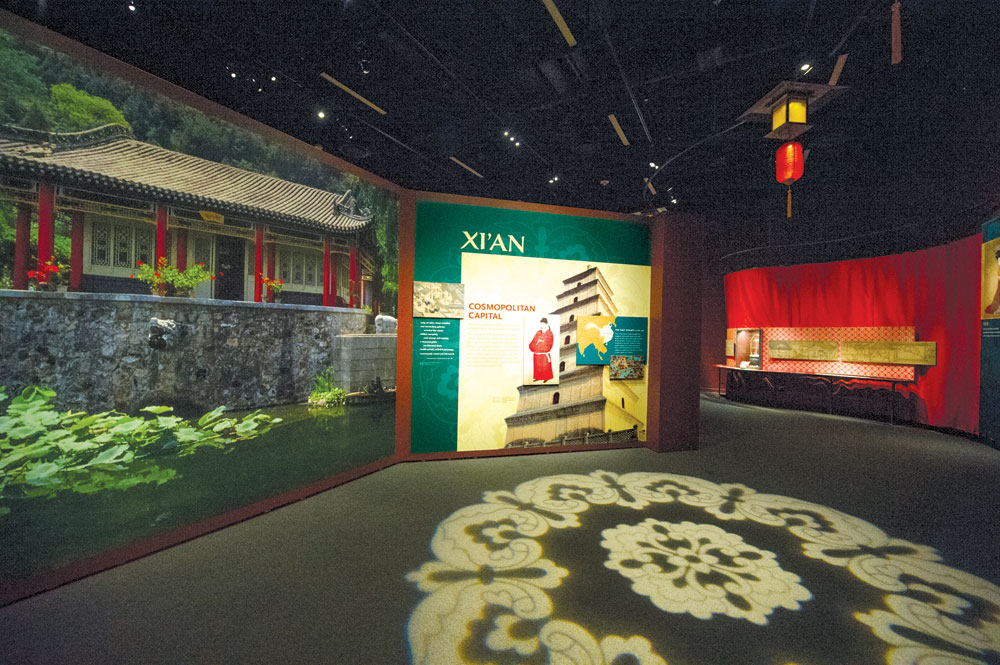
The city of Xi’an is the first stop of the featured cities in “Traveling the Silk Road.” Each city was 1000-1500 miles apart along this important trade route. Front Porch photos by Laura Mahony
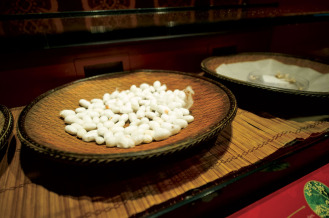
DMNS displays and also tends to living silk worms, their cocoons and the moths they become to show the lifecycle of the makers of all-important silk strands.
Get ready to travel on a 5,700-mile journey over hot deserts and frigid mountain passes, through five cities along the most celebrated trade route in human history. But don’t worry, no luggage is required, not even a carry-on. Instead, become immersed in foreign lands from the comfort of the Denver Museum of Nature & Science’s “Traveling the Silk Road” exhibit, open through May 3, 2015.
Artifacts and recreations of the goods that defined the route are featured including gold, art, glass, fur, wine, spices, dyes and silk. The exhibit shows how they were used and traded in cities that flourished at the time: Xi’an, ancient capital of China; Turfan, a fertile oasis; Samarkand, a grand city of commerce: Baghdad, the scholarly center of the Islamic world: and Constantinople, eastern capital of the Roman Empire.
As visitors explore the exhibit, Jennifer Moss Logan, educator/coordinator for Nature & Culture Gallery Programs at the museum, says to keep in mind the distances people travelled along the Silk Road route. “You travelled 1,000–1,500 miles from each of the cities,” she says. “And there is not a Costco along the way or a gas fill up or a nice little place to stay. This is harsh desert and high mountains! So it’s an incredible landscape.”
The exhibit covers the Silk Road’s golden age from A.D. 600 to 1200, telling dramatic stories through displays, hands-on activities and five costumed re-enactors who portray different roles, telling personal stories about life on the famous trade route. Don’t even try to get them to break from character to address the modern day. They won’t do it.
Visitors start their journey learning about the discovery that a cute caterpillar could lead to a beautiful gown (hint: it involves an ancient cup of tea). To explain the life cycle of silkworms, the museum has taken on daycare duties, displaying real silkworms, their cocoons and the moths they become. “We’re raising them here so there’s a lot of big work happening behind the scenes to provide these beautiful silkworms in their various forms,” explains Logan. A giant Tang-era weaving loom and examples of colorful, patterned silk fabric show what can be done with the strands from those small, white caterpillars.
A variety of musical instruments are displayed with push buttons to play tunes made by each instrument. Play each individually or together to create a song. The exhibit calls it “Road Music” because travelers along the Silk Road route would meet but wouldn’t necessarily know each other’s language, so playing music together was their way of communicating.
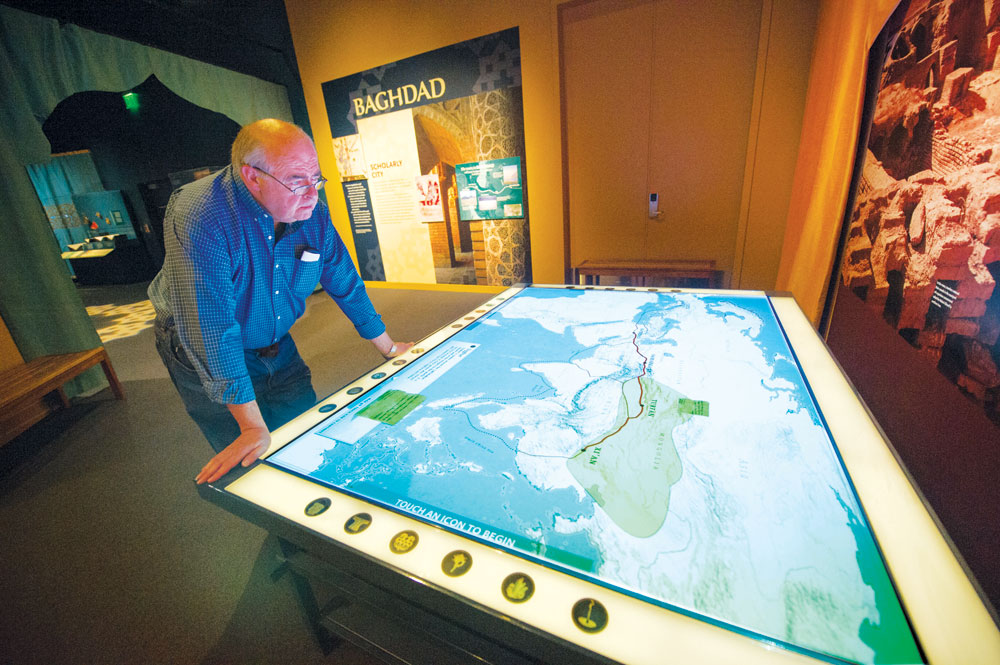
An interactive touch screen shows the various locations of stops along the Silk Road including details about the art, religion, music and other aspects of life happening at the time.
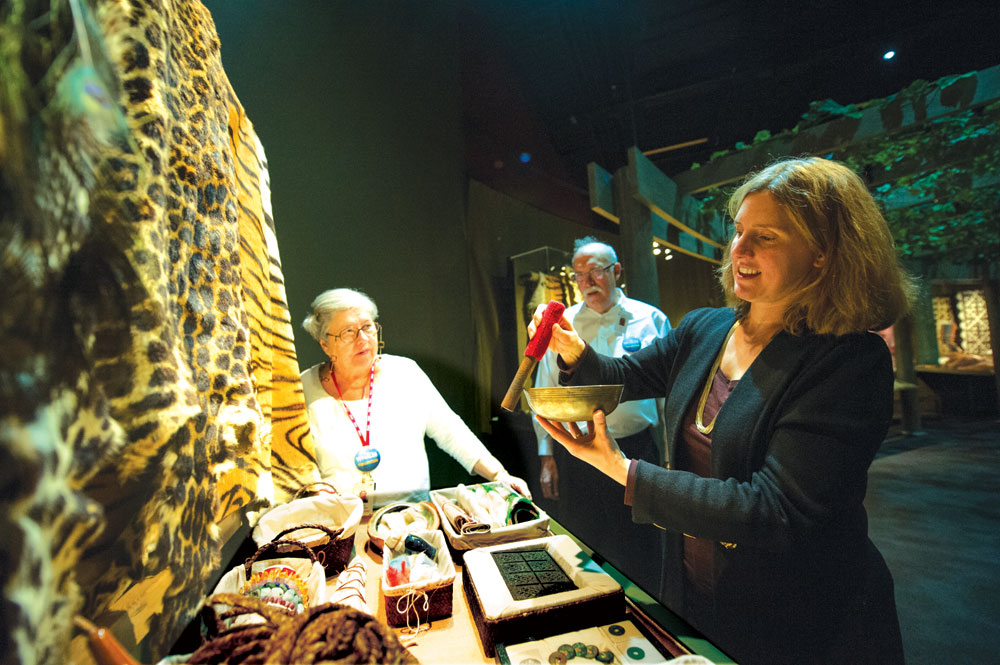
Jennifer Moss Logan, educator/coordinator for Nature & Culture Gallery Programs at the museum, examines items at one of the exhibit’s hands-on carts showing the type of merchandise that would be found at a market.
A full-scale re-creation of a night market in Turfan lets people see the various goods that would have been for sale including silks and other fabrics, food and animal skins for adornment and status. Sounds of market hubbub can be heard. Large pots with swiveling lids let visitors smell fragrant essences of the market including rosewater and patchouli. A hands-on demonstration cart provides the chance to touch items that might have been sold in the market.
A large animated book tells three illustrated stories of the Silk Road. Nearby, an interactive touch screen shows a map of the Silk Road displaying the connections between cultures in areas such as technology, music, religion and geography. A model of a half-view of a 71-foot-long Arab ship reveals cargo of ceramics and other heavier items, illustrating how merchants could move heavier and more diverse goods by boat.
In the richly decorated Baghdad area of the exhibit, there is a tribute to 1,000 years of the House of Wisdom, a library and translation institute that was a major destination for intellectuals around A.D. 800. Scholars of all religions were being sent to gather the knowledge of the world. “They were testing hypotheses and mathematics, thinking about chemistry, physics, thinking about the medicines and translating things from Latin into Arabic,” says Logan. “There was an appreciation of all that the world had to offer.”
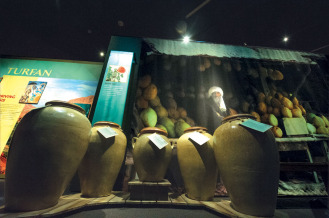
Slide open the lids of the large vessels in the night market to smell exotic essences typically found in the market such as rosewater, musk and patchouli.
“What I love about this exhibition is that when you visit these cities, you are seeing them in their ancient times but you are also seeing them today,” says Logan. “When you think about Baghdad, what do you think about today? We think about perhaps 10 years of angst. Visitors will have the chance to learn about the rich, diverse and all-encompassing wisdom of Baghdad and take away perhaps a counterpoint to what they may be seeing on the news.”
Tickets to “Traveling the Silk Road” include admission to the museum and range from $4–$7 for members and $14.95–$22.95 for nonmembers.



0 Comments